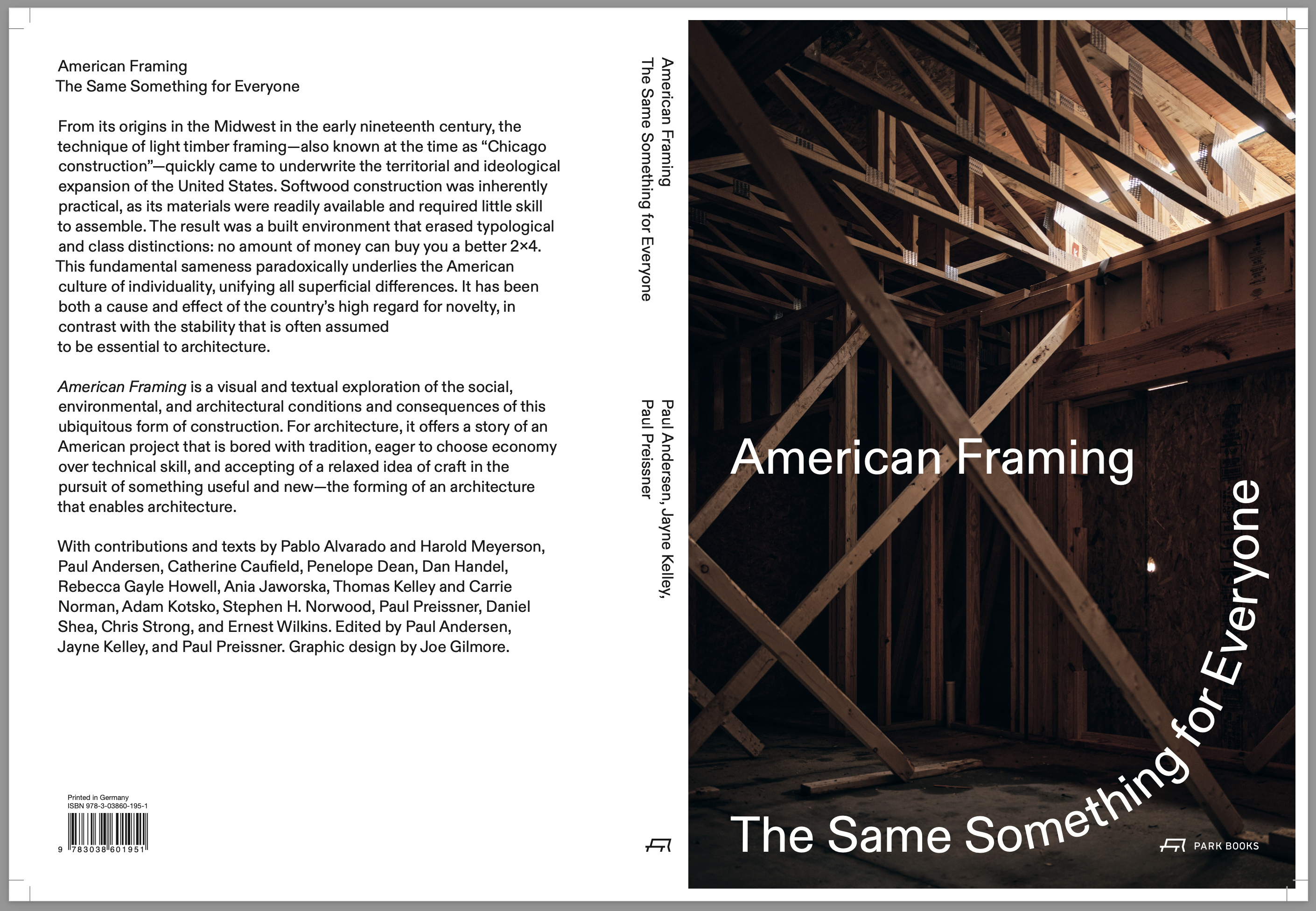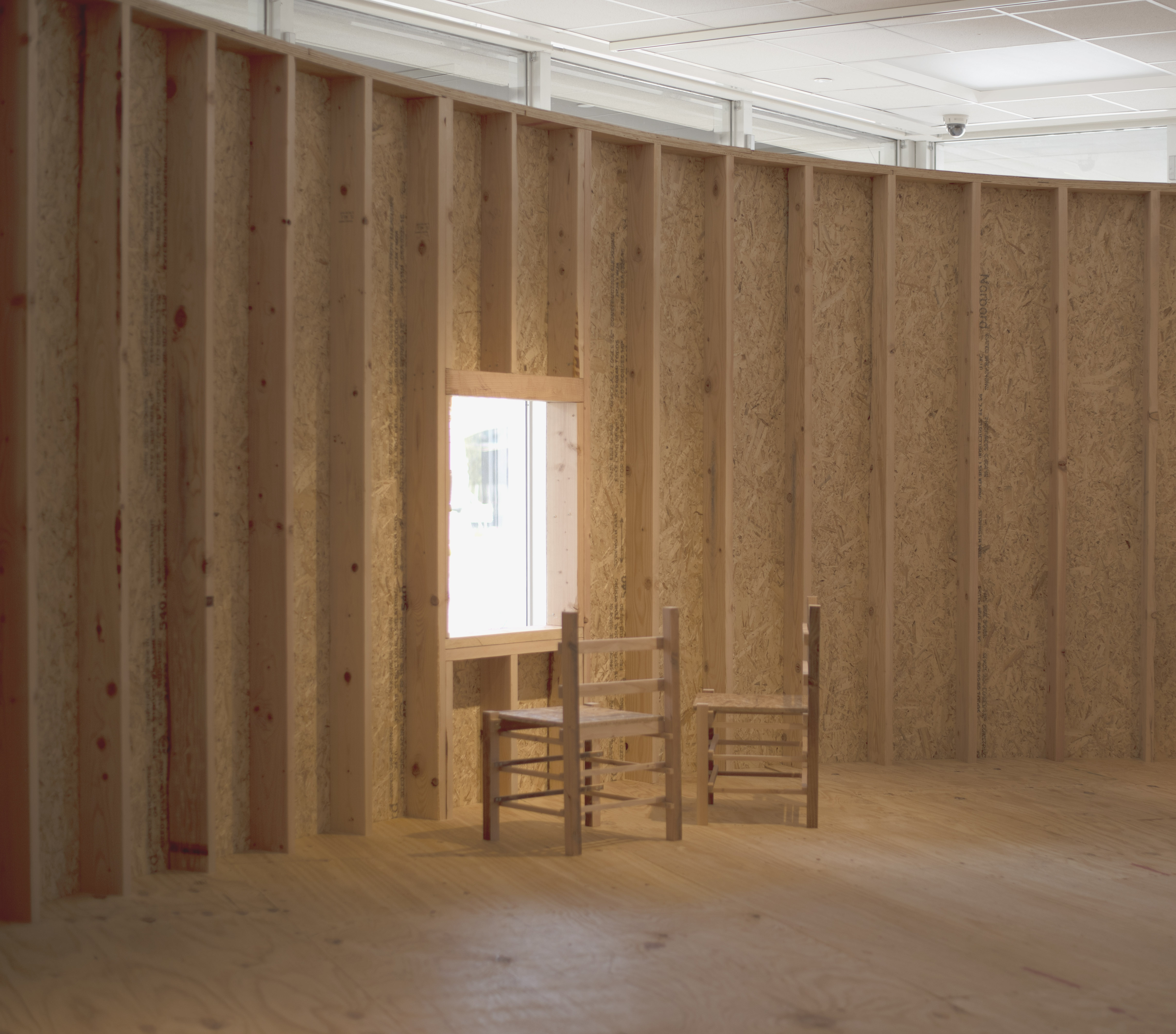



















































































US Pavilion at the 35th Venice Biennale, 1970. © Viesulas Estate
Originating in the early 19th century, softwood construction was a pragmatic solution to a need for an accessible building system among settlers with limited wealth, technical skills, and building traditions. Early examples, like George Washington Snow’s balloon framed warehouse, paved the way for churches, barns, stores, and the most common wood framed building type, the American house. An abundance of Southern Pine and Douglas Fir forests, simplicity and speed of construction, and an ability to be built by low or un-skilled workers made wood framing a perfect fit for the growing economies and populations of the American Midwest.
It has been the dominant construction system ever since—more than 90% of new homes in the U.S. today are wood framed. The accessibility that shaped its early development continues to influence contemporary life and reflect democratic ideals in subtle, but powerful ways. For instance, softwood construction is exceptionally egalitarian. No amount of money can buy you a better 2x4 than the 2x4s in the poorest neighborhood in town. This fundamental sameness paradoxically underlies the American culture of individuality, unifying all superficial differences. Buildings of every size and style are made of wood framing.
Despite its ubiquity, wood framing is perhaps the country’s most overlooked contributions to architecture. A variety of prejudices and habits explain its absence from intellectual discourse, which tends to zero in on the exotic while ignoring the ordinary. In the case of wood framing, a lack of disciplinary prestige stems from the same characteristics that make it so prevalent—it’s easy, thin, and inexpensive. These qualities introduce a flexibility for form, labor, composition, class, sensibility, access, and style that open up wild possibilities for architecture. Wood framing is inherently redundant and transient, which allows for improvisation in design and construction, rough detailing, and ongoing renovation. It has been both a cause and effect of the country’s high regard for novelty, in contrast with the stability that is often assumed to be essential to architecture.
The exhibition presents the subject of wood framing in a collection of works throughout the galleries and grounds of the U.S. Pavilion at the 17th International Architecture Exhibition, La Biennale di Venezia. A four-story installation forms a new façade for the historic pavilion—a half-section of a wood framed house through which visitors enter the exhibition. This open-air wood structure encloses the courtyard to provide space for reflection and conversation. It also introduces the world of wood framing as directly as possible by allowing people to experience its spaces, forms, and techniques firsthand. The full-scale work expresses the sublime and profound aesthetic power of a structural method that underlies most buildings in the United States.
Two types of works are exhibited within the galleries. Newly commissioned photographs from Daniel Shea and Chris Strong address the labor, culture, and materials of softwood construction. A collection of scale models, researched and designed by students at the University of Illinois at Chicago School of Architecture, presents the history of wood framing. Two sets of furniture by Ania Jaworska and Norman Kelley are installed outside in the courtyard and full-scale wood structure, both reviving historic pieces and producing them out of common dimensional lumber.
The 17th International Architecture Exhibition of La Biennale di Venezia comes at a time when national cultural practices are struggling with their histories. How do we come to terms with our past choices? What kinds of futures can we create? American Framing examines the improbably overlooked and familiar architecture of the country’s most common construction system and argues that a profound and powerful future for design can be conceived out of an ordinary past. The works within the exhibition tell the story of an American architectural project that is bored with tradition, eager to choose economy over technical skill, and accepting of a relaxed idea of craft in the pursuit of something useful and new.
This website, the presentation of the Pavilion of the United States at Biennale Architettura 2021, its instagram: @americanframing, the subsequent 2022 exhibition at Wrightwood 659 in Chicago, US and Galerie Jaroslava Fragnera in Prague, CZ, and the associated book: American Framing: The Same Something for Everyone (Park Books) are about that.
External Links:
Ania Jaworska
Norman Kelley
Daniel Shea
Chris Strong
Wrightwood 659 2022
Galerie Jaroslava Fragnera 2022
Palm Springs Art Museum 2023
American Framing at Palm Springs Art Museum Palm Springs 2023
12 January – 2 July 2023
American Framing at Galerie Jaroslava Fragnera Prague 2022
28 April – 24 June 2022
American Framing at Wrightwood 659 Chicago 2022
6 May – 16 July 2022
Biennale Architettura 2021
22 May – 21 November 2021
Opening Hours
Tu-Su 11a – 7p (Last admission: 6:45p) 22 May – 31 July
Tu-Su 10a – 6p (Last admission: 5:45p) 1 August – 21 November
*Closed on Mondays (except 24 May, 5 July, 26 July, 30 August, 6 September, 1 November, 15 November).
*Closed to the public 8 – 11 July in compliance with the provisions of the competent authorities relating to the G20 meeting in Venice.
Pre-opening: Biennale Architettura 2021
20 – 21 May 2021
Inauguration of the Pavilion of the United States
11a, 21 May 2021
Exhibition Tours with Pauls!
11a, 29 August 2021
11a, 24 & 25 September 2021
11a, 20 & 21 November 2021
Pavilion Days
23 – 24 September 2021
BYOB Closing Party thing at the US Pavilion!
4p, 21 November 2021
Paul Andersen and Paul Preissner
Commissioners/Curators
Exhibitors
Ania Jaworska
Norman Kelley
Daniel Shea
Chris Strong
with UIC School of Architecture students
Emory Alba
Kassandra Alvarez
Alondra Ayala
Hannah Bernas
Kenda Blanks
Sama Jafarnejad Chaghoshi
M. Lorenze Cordova
Luna Vital Gallego
Nathan Gawlinski
Ronald Hall
Esau Hernandez
Summer Hofford
Andrew Hunt
Andrew Huss
Jeffri Jacobe
Colin Jecha
Nash Kennedy
Tina Kracke
Riley Kyrouac
Sohui Lee
Rizna Rafi Maalouf
Shamsedin Mokhber
Courtney Moushi
Martin Murungi
Kayla Oliver
Yamileth Ovalle
Jacob Patnode
Morgan Peterson
Sam Piombino
Meghan Quigley
Mallory Rabeneck
Ricardo Sandoval
Jocelyn Schneider
Cody Schueller
Martina Smith
Lia Thompson
Julia Turner
Giselle Valle Figueroa
Andreina Yepez
Roya Zanjani
Joe Gilmore
Graphic Design
Richard Cool
Website Development
Judith De Jong
Project Manager
Drew Stanley
Project Architect
Adriann Anderson
Project Administration
Giacomo Di Thiene
Executive Architect in Venice
Goodfriend Magruder Structure, LLC
Structural Engineer
Chiara Barbieri
Special Projects Coordinator, Peggy Guggenheim Collection
Karole P. B. Vail
Director of the Peggy Guggenheim Collection and Foundation Director for Italy
Resnicow and Associates
Communications
Impresa Edile Francesco Minto S.n.c.
Grosso Srl
Construction Services
American Framing is made possible by:
The Bureau of Educational and Cultural Affairs (ECA)
of the U.S. Department of State
The National Endowment for the Arts
The University of Illinois Chicago
and the collaboration of The Solomon R. Guggenheim Foundation
American Framing is generously sponsored by:
Alphawood Foundation
HDR
Glen-Gery Corporation/Brickworks
Graham Foundation
Media Sponsor for American Framing:
Architectural Record
Additional support from:
Thornton Tomasetti Foundation
Joseph and Mary Burns
Brooklyn PrintWorks
Selected Articles
April 1, 2022 The Architect's Newspaper
July 23, 2021 Arquitectura y Empresa
June 25, 2021 Harper's Bazaar
June 21, 2021 reSITE
June 16, 2021 Architectural Record
June 12, 2021 Rai News
June 9, 2021 Interior Design
June 9, 2021 Le Journal des Arts
June 7, 2021 Bau Meister
June 6, 2021 Pin-Up
June 4, 2021 Dezeen
June 4, 2021 la Repubblica
June 3, 2021 Architect Magazine
June 2, 2021 Architect Magazine
June 2, 2021 The New York Times
June 1, 2021 Monocle Radio
June 1, 2021 Architectural Digest
May 28, 2021 Strelka Mag
May 28, 2021 Architectural Digest
May 28, 2021 Artnet
May 28, 2021 Architects' Journal
May 28, 2021 Arch Daily
May 27, 2021 Domus
May 27, 2021 professione Architetto
May 26, 2021 Financial Times
May 26, 2021 Domus
May 26, 2021 The Architects' Newspaper
May 26, 2021 Quartz
May 25, 2021 Architectural Record
May 25, 2021 Elle Decor
May 25, 2021 Australian Design Review
May 25, 2021 Dezeen
May 24, 2021 Le Figaro
May 24, 2021 Global Design News
May 22, 2021 Domus
May 22, 2021 Bloomberg
May 22, 2021 Domus
May 22, 2021 Der Tagesspiegel
May 21, 2021 the Guardian
May 21, 2021 World Architecture
May 20, 2021 Dezeen
May 20, 2021 The New York Times
May 20, 2021 designboom
May 19, 2021 The Architect's Newspaper
May 12, 2021 designboom
May 10, 2021 Artribune
May 7, 2021 The Plan
April 30, 2021 ArchDaily
April 21, 2021 Architectural Record
April 19, 2021 Chicago Tribune
April 2, 2021 The Architect's Newspaper
March 27, 2020 Metropolis Magazine
March 11, 2020 The Architect's Newspaper
For inquiries, please contact: USPavilion2021@resnicow.com
To download the press kit for the 2021 U.S. Pavilion, please provide the requested information below.
US Pavilion at the 35th Venice Biennale, 1970. © Viesulas Estate